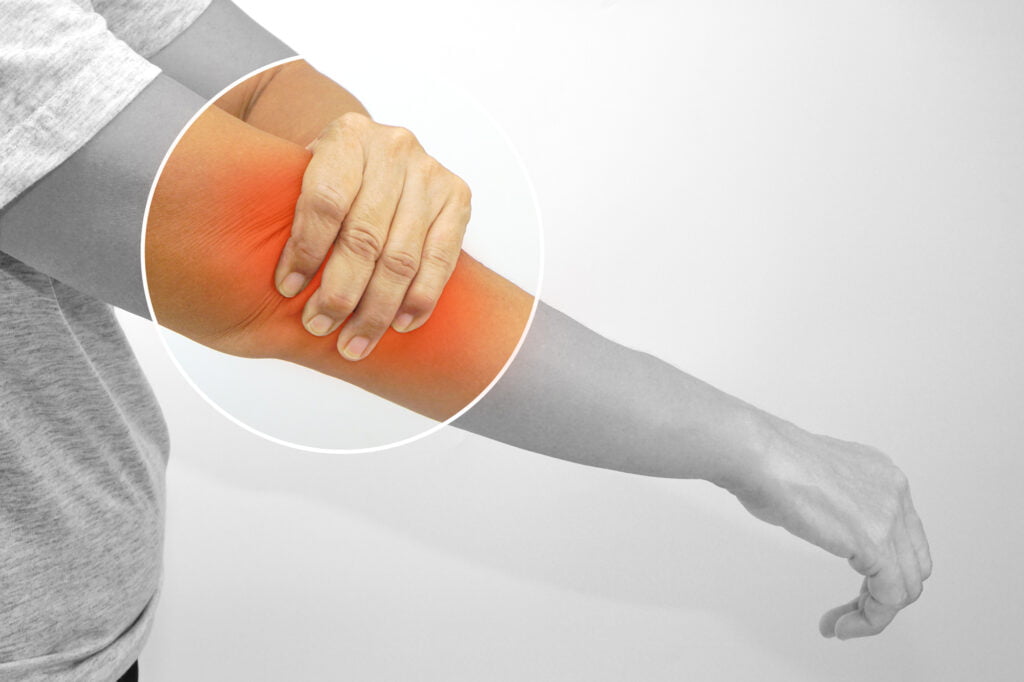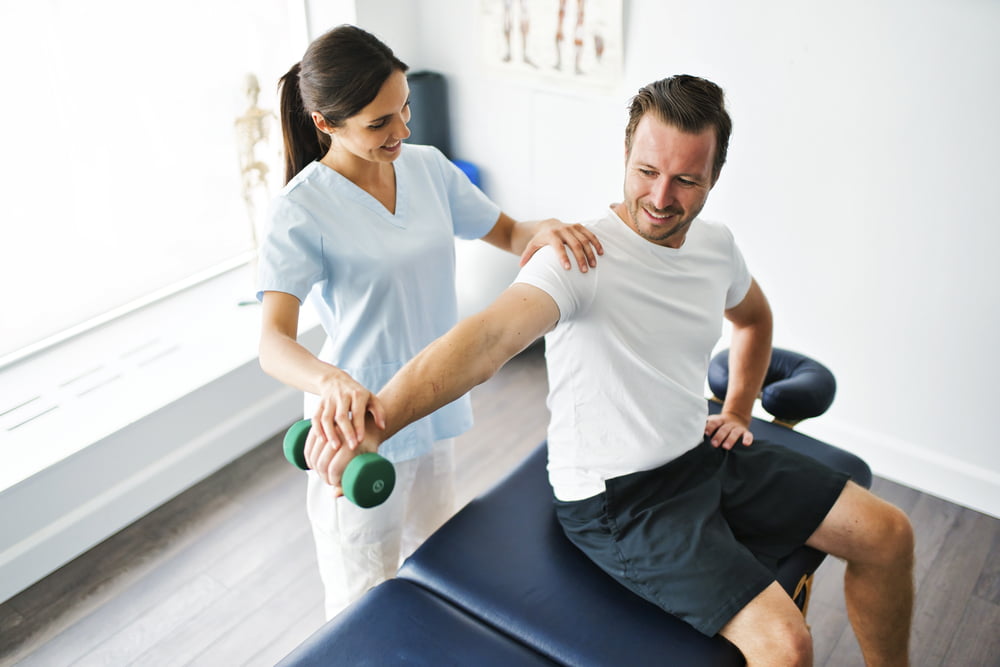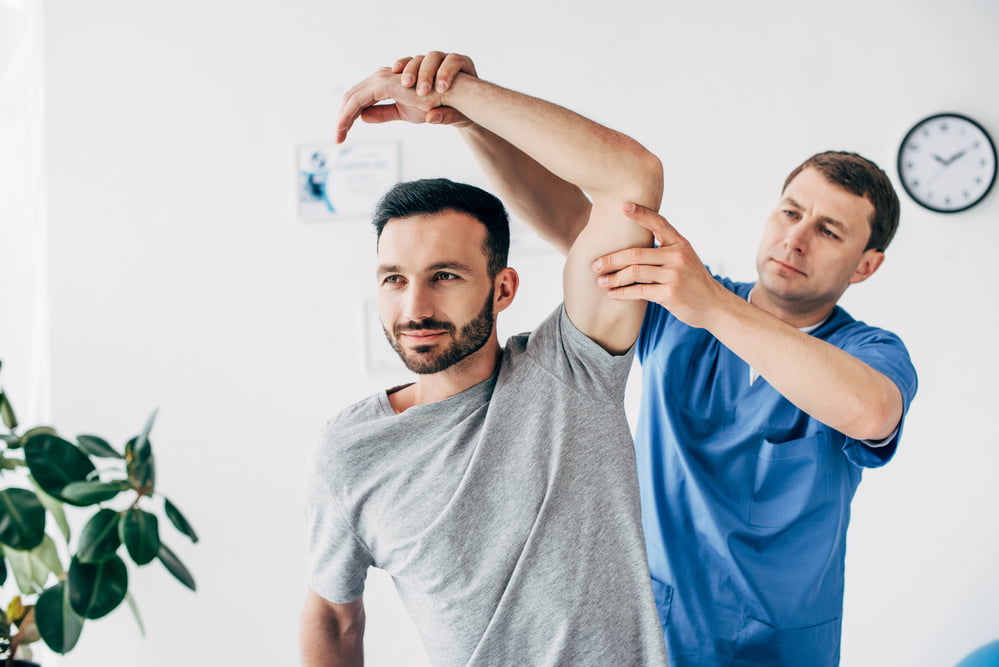
Elbow pain can be uncomfortable at best, and crippling at worst. You don’t have to live with elbow pain; our Physiotherapists and Athletic Therapist can help.
We offer effective, non-surgical, drug-free treatments for elbow pain. Our team of Physiotherapists and Athletic Therapist will find the source of your elbow pain and treat it, giving you the tools you need to prevent future injuries and manage or eliminate chronic pain.
Common Causes of Elbow Pain
Elbow Sprain / Strain
Elbow strain and elbow sprain are two similar conditions: A sprain occurs when ligaments stretch or tear as a result of an injury and a strain occurs when the fibres of your muscles or tendons experience minor trauma over time such as repetitive strain or overuse injury (no specific mechanism of injury occurred, it happens slowly over time). This can lead to the commonly heard diagnosis of “tennis elbow”. Muscle strains happen due to injury. Both can lead to reduced mobility, strength, pain, and swelling.
Ulnar collateral ligament (UCL) injury
The UCL is located on the inside of the elbow; the same side of your arm as your pinky. UCL injuries typically occur as a result of repetitive stress (repeated throwing or overhead use) or an awkward throw or landing, most commonly caused by throwing or overhead arm use. This places the upper extremity in a quadrant position or 90-degree angle at the elbow which is a very vulnerable position for the UCL. The injury is particularly common in children, especially baseball pitchers, under the age of 15.
Little League Elbow
Little League Elbow is another overuse injury caused by repetitive throwing that’s common in young athletes. Unlike UCL injuries, Little League Elbow affects the growth plates in the elbow—these are layers of cartilage near the end of a bone which contribute to growth.
Eventually, growth plates “close” or harden into bone, but before then, they are easily injured. Muscles, ligaments, and tendons around the arm bones stabilize the elbow and support the movements of the arm.
During an overhead throw, the arm moves through several extreme positions at high speed, putting the elbow under a great deal of stress.
When players between 9 and 14 years old especially throw too much without rest, the elbow can become inflamed and sore. Without sufficient rest, the ligaments and tendons may tear away from the bone or parts of the bone can separate from each other. This can happen when kids are on multiple teams.
Tendinopathy
Tendinopathy is a broad term for tendon conditions that cause pain and swelling. In the elbow, there are two common types of tendinopathy: Tennis elbow and golfer’s elbow.
Tennis elbow
Tennis elbow (lateral epicondylitis) is an injury in the extensor tendons; this means it affects the muscles used to bend your wrist backward and straighten your fingers. These muscles would be on the side of the forearm that would contact the sun (outer side). The injury commonly occurs in tennis players, but it can affect many athletes, as well as anyone who regularly lifts heavy weights. Tennis elbow can make it difficult to turn doorknobs or open jars.
Golfer’s elbow
Golfer’s elbow (medial epicondylitis) is an injury of the flexor tendons; this means it affects the muscles used to close your fingers into a fist and flex your wrist. These muscles would be on the side of the forearm that wouldn’t contact the sun (inner side). The injury commonly occurs in golfers, but like tennis elbow, it can affect many athletes, as well as weight lifters, and people in construction, plumbing, and similar industries.
Arthritis: Rheumatoid, Osteoarthritis, and Psoriatic
Arthritis is joint pain, typically accompanied by stiffness and swelling. There are several types of arthritis that can affect the elbow, including rheumatoid arthritis (an autoimmune disease), osteoarthritis (caused by wear and tear), and psoriatic arthritis (caused by psoriasis).
Nerve Injuries
Nerve injuries in the elbow are common and can be caused by repetitive motion, prolonged use of vibratory machinery, and continuous computer use. They may lead to pain and tingling sensations. Ulnar nerve entrapment (cubital tunnel syndrome) is one common nerve injury that can occur in elbows. The most common, however, is called carpal tunnel syndrome. This occurs when the medial nerve gets entrapped.
Olecranon Bursitis
The olecranon bursa is a fluid-filled sac in your elbow joint. This sac reduces friction between bones and tendons and/or ligaments. Olecranon bursitis is inflammation in that sac. As with most elbow conditions, it’s more common in athletes and people with very physical jobs. The most common way to injure the bursa, however, is prolonged pressure. This means leaning onto the elbow when bent. The bony outgrowth called the olecranon pinches the bursa causing the irritation.
Elbow Fractures
Fractured elbows are typically the result of trauma; there are three main types (olecranon, radial head, and distal humerus fractures). They cause pain, discomfort, swelling, numbness, and other symptoms. These require an X-ray to confirm, and immobilization and rest to heal as prescribed by your Physician. It is when your fracture is healed that you can commence Physiotherapy or Athletic Therapy. Your recovery timeline depends on the extent of your injury. In most cases, people with elbow fractures will be in a cast or splint for at least three to six weeks. Many return to normal activities in approximately four months.
How To Know if You Need To Talk With a Physiotherapist

There are times you should visit your doctor for elbow pain, and times when it’s best to visit your Physiotherapist or Athletic Therapist. Here are a few ways you can distinguish between the two:
- When there’s sudden or severe pain in your elbow, see your doctor.
- When your elbow is at an unusual angle or you can see bone after an injury, go to the hospital.
- When there’s sudden swelling or bruising around the elbow joint, visit your doctor.
In most other cases, you can visit us first! We can work with your doctor and any other members of your medical team and create a personalized treatment plan to restore function to your elbow, all while reducing or eliminating pain.
Our team can help you if you experience elbow joint pain:
- When lifting objects
- When bending or straightening your arm
- When flexing or extending your fingers
- When at rest
We can help with all kinds of different elbow problems, including chronic pain, stiffness, and discomfort. Whether you need rehabilitation for an injury or a treatment plan for chronic problems like arthritis, our team is here to help.
Our Solution for Elbow Pain
When approaching elbow pain treatment, our goal is to eliminate or reduce pain, improve mobility, and restore your elbow to full health and function. We start with a comprehensive examination to determine the source of your discomfort. From there, we develop a personalized treatment plan.
Your treatment plan may include targeted exercises, stretches, hot and cold therapy, manual therapy, and more. We’ll also help you determine what caused the injury, and teach you how to avoid injuring your elbow in the future.
Treatment Options
Manual Therapy
Manual therapy includes a number of hands-on techniques to facilitate movement, reduce tension, encourage healing, and more. This can include massage, joint mobilization, soft tissue mobilization/stretching, and other techniques.
Therapeutic Exercise
Therapeutic exercises are used to reduce pain while restoring functionality to your elbow. We may teach you range of motion exercises, strength exercises, relaxation exercises, or other therapeutic exercises.
Physical Modalities
Physical modalities are a catch-all term for a variety of physiotherapy techniques. We offer a variety of modalities, including ultrasound, heat therapy, cryotherapy, laser therapy, IFC, TENS therapy, and more.
Education
Education is a key part of any physiotherapy treatment; our goal is to offer pain relief, but it’s also to help you avoid injuring yourself again. We’ll help you understand how you hurt your elbow and teach you how to avoid hurting it again in the future.

How Quickly Will the Pain Go Away?
In many cases, pain relief from physiotherapy and athletic therapy can occur almost instantly, though the relief may be temporary at first it should continue to last longer and longer as you improve. Our goal is to eliminate or alleviate pain on a more permanent basis. This process can take weeks or months, depending on the nature of your elbow pain. Our Physiotherapists and Athletic Therapist will work with you to find the right treatment choices to reduce or eliminate your pain.
Contact Us
At Fit4Life, we offer elbow pain relief and treatments in Winnipeg and the surrounding area. You can find relief from elbow pain—and we can help. Contact us today.



